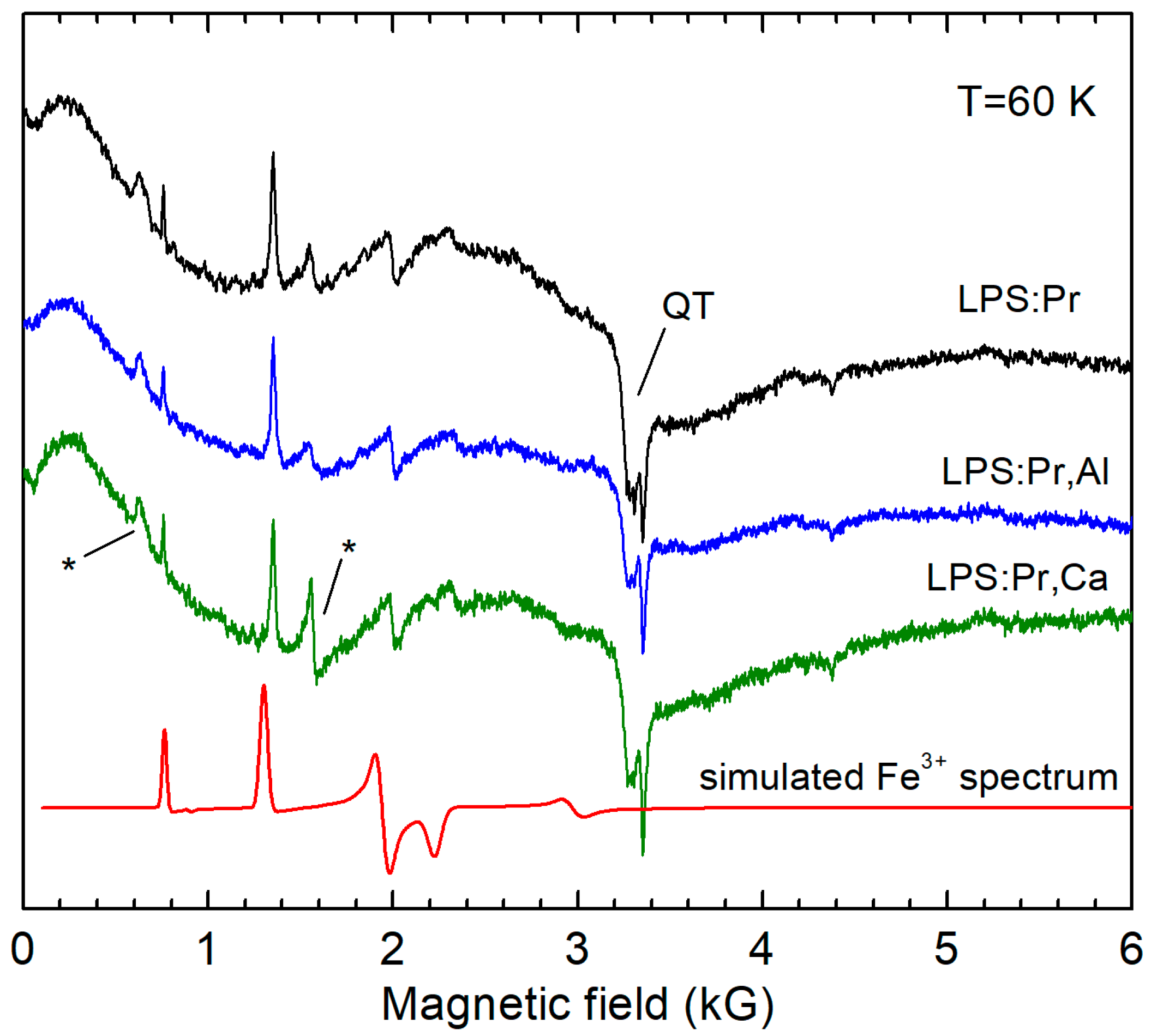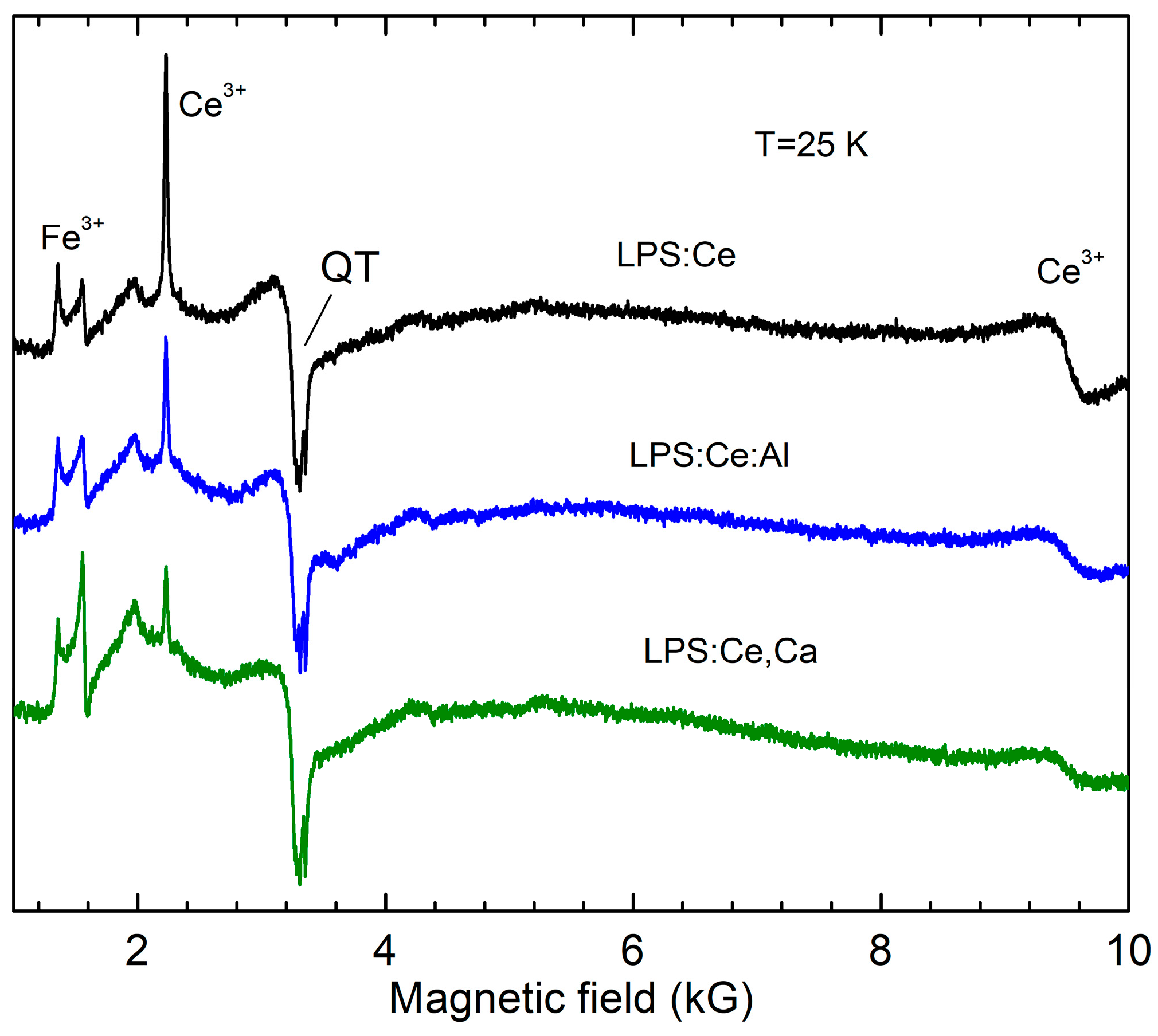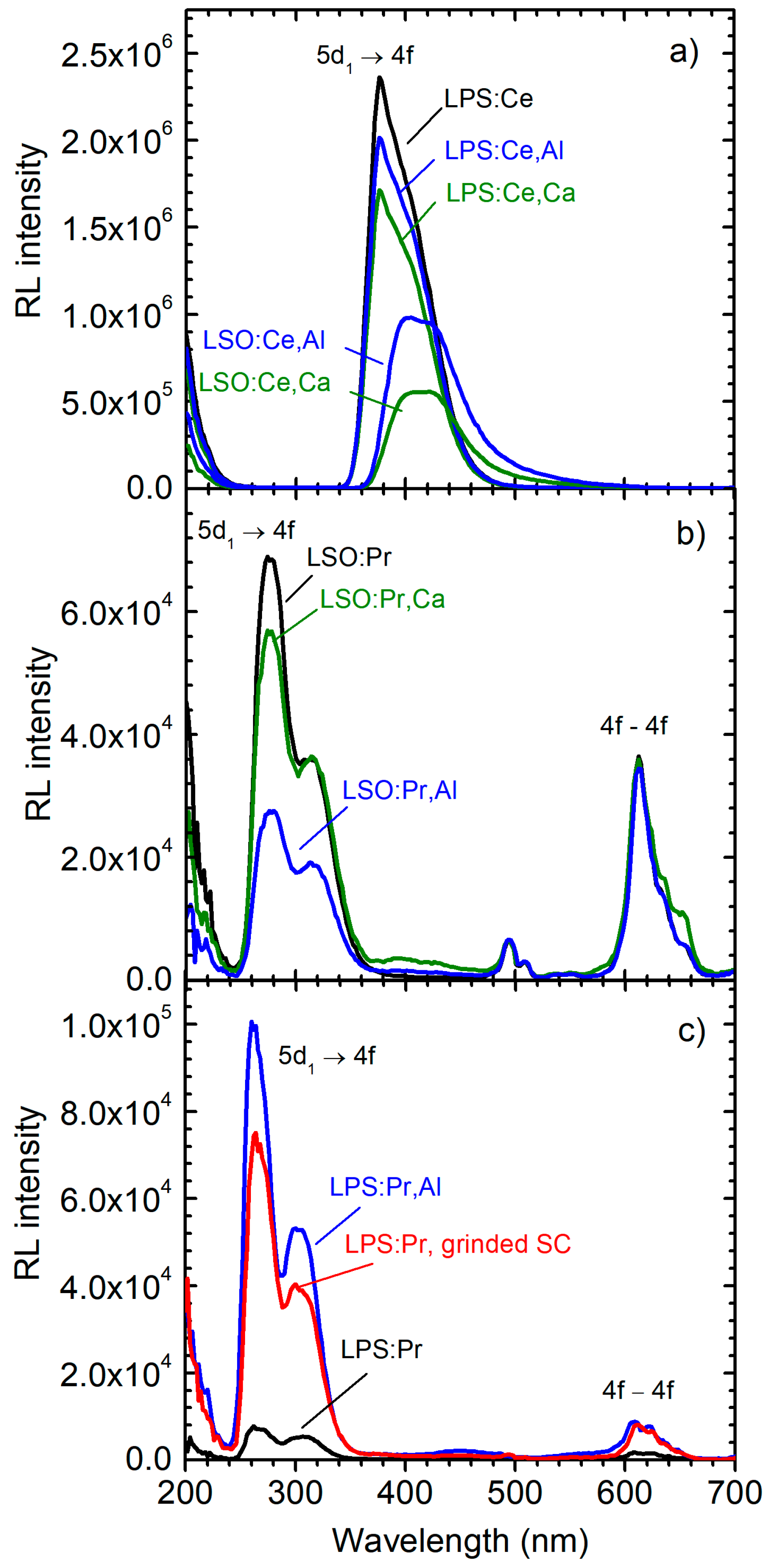Charge Transfer and Charge Trapping Processes in Ca- or Al-Co-doped Lu2SiO5 and Lu2Si2O7 Scintillators Activated by Pr3+ or Ce3+ Ions
Abstract
1. Introduction
2. Materials and Methods
3. Results
3.1. EPR Spectra in Ca and Al Co-doped LSO:Ce and LSO:Pr
3.2. EPR Spectra in Ca- and Al-Co-doped LPS:Ce and LPS:Pr
3.3. EPR Spectra Created by X-ray Irradiation in LPS:Ce, LPS:Pr, LSO:Ce, and LSO:Pr Co-doped with Ca2+ or Al3+ and Comparison with TSL
3.4. Scintillation Decay Time Measurements
4. Conclusions
Supplementary Materials
Author Contributions
Funding
Institutional Review Board Statement
Informed Consent Statement
Data Availability Statement
Acknowledgments
Conflicts of Interest
References
- Rodnyi, P.A. Physical Processes in Inorganic Scintillators; CRC Press: Boca Raton, FL, USA, 1997. [Google Scholar]
- Dujardin, C.; Auffray, E.; Bourret-Courchesne, E.; Dorenbos, P.; Lecoq, P.; Nikl, M.; Vasil’ev, A.N.; Yoshikawa, A.; Zhu, R.-Y. Needs, trends, and advances in inorganic scintillators. IEEE Trans. Nukl. Sci. 2018, 65, 1977–1997. [Google Scholar] [CrossRef]
- Wei, Q.; Shi, H.; Zhou, Z.; Liu, G.; Chen, Z.; Qin, L.; Shu, K.; Liu, Q. A study on the structure, luminescence and thermos-stability of polycrystalline Gd2Si2O7:Ce and (Gd,La)2Si2O7:Ce. J. Mater. Chem. C 2017, 5, 1443–1451. [Google Scholar] [CrossRef]
- Kantuptim, P.; Akatsuka, M.; Nakauchi, D.; Kato, T.; Kawaguchi, N. Scintillation properties of Pr-doped Lu2Si2O7 single crystal. Radiat. Meas. 2020, 134, 106320. [Google Scholar] [CrossRef]
- Lopez, L.; Pichon, P.; Loiseau, P.; Viana, B.; Mahiou, R.; Druon, F.; Georges, P.; Balembois, F. Ce:LYSO, from scintillator to solid-state lighting as a blue luminescent concentrator. Sci. Rep. 2023, 13, 7199. [Google Scholar] [CrossRef]
- Kantuptim, P.; Fukushima, H.; Kimura, H.; Nakauchi, D.; Kato, T.; Koshimizu, M.; Kawaguchi, N.; Yanagida, T. VUV- and X-ray-induced properties of Lu2Si2O7, Y2Si2O7, and Gd2Si2O7 single crystals. Sens. Mater. 2021, 33, 2195–2201. [Google Scholar] [CrossRef]
- Van Eijk, C.W.E. Inorganic scintillators in medical imaging. Phys. Med. Biol. 2002, 47, R85–R106. [Google Scholar] [CrossRef] [PubMed]
- Blahuta, S.; Bessière, A.; Viana, B.; Dorenbos, P.; Ouspenski, V. Evidence and consequences of Ce4+ in LYSO:Ce,Ca and LYSO:Ce,Mg single crystals for medical imaging applications. IEEE Trans. Nucl. Sci. 2013, 60, 3134–3141. [Google Scholar] [CrossRef]
- Wu, Y.; Peng, J.; Rutstrom, D.; Koschan, M.; Foster, C.; Melcher, C.L. Unraveling the critical role of site occupancy of lithium codopants in Lu2SiO5:Ce3+ single-crystalline scintillators. ACS Appl. Mater. Interfaces 2019, 11, 8194–8201. [Google Scholar] [CrossRef]
- Tian, J.; Xie, J.; Zhuang, W. Recent advances in multi-site luminescence materials: Design, identification and regulation. Materials 2023, 15, 2179. [Google Scholar] [CrossRef]
- Yang, K.; Melcher, C.L.; Rack, P.D.; Eriksson, L.A. Effects of calcium codoping on charge traps in LSO:Ce crystals. IEEE Trans. Nukl. Sci. 2009, 56, 2960–2965. [Google Scholar] [CrossRef]
- Spurrier, M.A.; Szupryczynski, P.; Yang, K.; Carey, A.A.; Melcher, C.L. Effect of Ca2+ co-doping on the scintillation properties of LSO:Ce. IEEE Trans. Nukl. Sci. 2008, 55, 1178–1182. [Google Scholar] [CrossRef]
- Ferrand, B.; Viana, B.; Pidol, L.; Dorenbos, P. Dense High-speed Scintillator Material of Low Afterglow. U.S. Patent 8,574,458 B2, 5 November 2013. [Google Scholar]
- Xue, Z.; Chen, L.; Zhao, S.; Yang, F.; An, R.; Wang, L.; Sun, Y.; Feng, H.; Ding, D. Enhancement of scintillation properties of LYSO:Ce crystals by Al codoping. Cryst. Growth Des. 2023, 23, 4562–4570. [Google Scholar] [CrossRef]
- Takasugi, T.; Yokota, Y.; Horiai, T.; Yoshino, M.; Yamaji, A.; Ohashi, Y.; Kurosawa, S.; Kamada, K.; Babin, V.; Nikl, M.; et al. Al-doping effects on mechanical, optical and scintillation properties of Ce:(La,Gd)2Si2O7 single crystals. Opt. Mater. 2019, 87, 11–15. [Google Scholar] [CrossRef]
- Pidol, L.; Kahn-Harari, A.; Viana, B.; Ferrand, B.; Dorenbos, P.; de Hass, J.T.M.; van Eijk, C.W.E.; Virey, E. Properties of Lu2Si2O7:Ce3+, a fast and efficient scintillator crystal. J. Phys. Condens. Matter 2003, 15, 2091–2102. [Google Scholar] [CrossRef]
- He, F.; Guohao, R.; Yuntao, W.; Jun, X.; Qiuhong, Y.; Jianjun, X.; Mitch, C.; Chenlong, C. Optical and thermoluminescence properties of Lu2Si2O7:Pr single crystal. J. Rare Earths 2012, 30, 775–779. [Google Scholar]
- Laguta, V.V.; Buryi, M.; Rosa, J.; Savchenko, D.; Hybler, J.; Nikl, M.; Zazubovich, S.; Karner, T.; Stanek, C.R.; McClellan, K.J. Electron and hole traps in yttrium orthosilicate single crystals: The critical role of Si-unbound oxygen. Phys. Rev. B 2014, 90, 64104. [Google Scholar] [CrossRef]
- Mihóková, E.; Fasoli, M.; Moretti, F.; Nikl, M.; Jary, V.; Ren, G.; Vedda, A. Defect states in Pr3+ doped lutetium pyrosilicate. Opt. Mater. 2012, 34, 872–877. [Google Scholar] [CrossRef]
- Dorenbos, P.; van Eijk, C.W.E.; Bos, A.J.J.; Melcher, C.L. Afterglow and thermoluminescence properties of Lu2SiO5:Ce scintillation crystals. J. Phys. Condens. Matter 1994, 6, 4167. [Google Scholar] [CrossRef]
- Laguta, V.; Buryi, M.; Wu, Y.; Ren, G.; Nikl, M. Electron and hole trapping in Ce3+- and Pr3+-doped lutetium pyrosilicate scintillation crystals studied by electron paramagnetic resonance. Phys. Rev. Appl. 2020, 13, 044060. [Google Scholar] [CrossRef]
- Aykol, M.; Montoya, J.H.; Hummelshoj, J. Rational solid-state synthesis routes for inorganic materials. J. Am. Chem. Soc. 2021, 143, 9244–9259. [Google Scholar] [CrossRef]
- Gustafsson, T.; Klintenberg, M.; Derenzo, S.E.; Weber, M.J.; Thomas, J.O. Lu2SiO5 by single-crystal X-ray and neutron diffraction. Acta Crystallog. C 2001, 57, 669. [Google Scholar] [CrossRef]
- Bretheau-Raynal, F.; Lance, M.; Charpin, P. Crystal data for Lu2Si2O7. J. Appl. Cryst. 1981, 14, 349–350. [Google Scholar] [CrossRef]
- Pidol, L.; Guillot-Noël, O.; Kahn-Harari, A.; Viana, B.; Pelenc, D.; Gourier, D. EPR study of Ce3+ ions in lutetium silicate scintillators Lu2Si2O7 and Lu2SiO5. J. Phys. Chem. Solids 2006, 67, 643–650. [Google Scholar] [CrossRef]
- Pilbrow, J.R. Transition Ion Electron Paramagnetic Resonance; Clarendon Press: Oxford, UK, 1990. [Google Scholar]
- Abragam, A.; Bleaney, B. Electron Paramagnetic Resonance of Transition Ions; Clarendon Press: Oxford, UK, 1970. [Google Scholar]
- Buryi, M.; Laguta, V.; Babin, V.; Laguta, O.; Brik, M.G.; Nikl, M. Rare-earth ions incorporation into Lu2Si2O7 scintillator crystals: Electron paramagnetic resonance and luminescence study. Opt. Mater. 2020, 106, 109930. [Google Scholar] [CrossRef]
- Schirmer, O.F. O− bond small polarons in oxides materials. J. Phys. Condens. Matter 2006, 18, R667. [Google Scholar] [CrossRef]
- Feng, H.; Ding, D.; Li, H.; Lu, S.; Pan, S.; Chen, X.; Ren, G. Annealing effects on Czochralski grown Lu2Si2O7:Ce3+ crystals under different atmospheres. J. Appl. Phys. 2008, 103, 083109. [Google Scholar] [CrossRef]
- Pidol, L.; Viana, B.; Kahn-Harari, A.; Bessiere, A.; Dorenbos, P. Luminescence properties and scintillation mechanisms of Ce3+-, Pr3+- and Nd3+-doped lutetium pyrosilicate. Nukl. Instr. Methods Phys. Res. A 2005, 537, 125–129. [Google Scholar] [CrossRef]








| Theoretical Sample Formula | Designation in the Text |
|---|---|
| Lu1.996Ce0.004SiO5 | LSO:Ce |
| Lu1.986Ce0.004Ca0.01SiO5 | LSO:Ce,Ca |
| Lu1.996Ce0.004Si0.995Al0.005O5 | LSO:Ce,Al |
| Lu1.996Ce0.004Si2O7 | LPS:Ce |
| Lu1.986Ce0.004Ca0.01Si2O7 | LPS:Ce,Ca |
| Lu1.996Ce0.004Si1.99Al0.01O7 | LPS:Ce,Al |
| Lu1.996Pr0.004SiO5 | LSO:Pr |
| Lu1.986Pr0.004Ca0.01SiO5 | LSO:Pr,Ca |
| Lu1.996Pr0.004Si0.995Al0.005O5 | LSO:Pr,Al |
| Lu1.996Pr0.004Si2O7 | LPS:Pr |
| Lu1.986Pr0.004Ca0.01Si2O7 | LPS:Pr,Ca |
| Lu1.996Pr0.004Si1.99Al0.01O7 | LPS:Pr,Al |
| Material | Spin Hamiltonian Parameters | HF Constant | Reference |
|---|---|---|---|
| LSO:Ce LSO:Pr | Ce3+: g1 = 2.262 g2 = 1.686 g3 = 0.563 Fe3+: g = 1.99 = 0.165 cm−1 = 0.165 cm−1 | This paper, [25] | |
| This paper | |||
| LPS:Ce LPS:Pr | Ce3+: g1 = 3.000 g2 = 0.705 g3 ≈ 0.10 Fe3+: g = 2.00 = 0.700 cm−1 = 0.380 cm−1 | This paper, [25,28] | |
| This paper | |||
| LPS:Ce,Al | O−: g = 2.012 | Not determined | This paper |
| LPS:Ce,Ca | O−: g = 2.011 | 175Lu: A00 = 4.0 × 10−4 cm−1 | This paper |
| Composition | τ1 (ns) | I1 (%) | τ2 (ns) | I2 (%) |
|---|---|---|---|---|
| LPS:Ce | 11.5 | 31.3 | 36.3 | 68.7 |
| LPS:Ce,Al | 11.4 | 32.2 | 36.1 | 67.8 |
| LPS:Ce,Ca | 10.8 | 32.5 | 35.5 | 67.5 |
| LPS:Ce, SC | 35.8, 38 * | 100 | ||
| LSO:Ce,Al | 10.3 | 46.1 | 33.1 | 53.9 |
| LSO:Ce,Ca | 9.8 | 50.8 | 32.9 | 49.2 |
| LSO:Ce, SC | 40 * | 100 | ||
| LPS:Pr | 13.6 | 69.0 | 30.8 | 31.0 |
| LPS:Pr,Al | 12.6 | 69.7 | 30.2 | 30.3 |
| LPS:Pr, SC | 20 **, 15 *** | 100 |
Disclaimer/Publisher’s Note: The statements, opinions and data contained in all publications are solely those of the individual author(s) and contributor(s) and not of MDPI and/or the editor(s). MDPI and/or the editor(s) disclaim responsibility for any injury to people or property resulting from any ideas, methods, instructions or products referred to in the content. |
© 2023 by the authors. Licensee MDPI, Basel, Switzerland. This article is an open access article distributed under the terms and conditions of the Creative Commons Attribution (CC BY) license (https://creativecommons.org/licenses/by/4.0/).
Share and Cite
Laguta, V.; Havlak, L.; Babin, V.; Barta, J.; Pejchal, J.; Nikl, M. Charge Transfer and Charge Trapping Processes in Ca- or Al-Co-doped Lu2SiO5 and Lu2Si2O7 Scintillators Activated by Pr3+ or Ce3+ Ions. Materials 2023, 16, 4488. https://doi.org/10.3390/ma16124488
Laguta V, Havlak L, Babin V, Barta J, Pejchal J, Nikl M. Charge Transfer and Charge Trapping Processes in Ca- or Al-Co-doped Lu2SiO5 and Lu2Si2O7 Scintillators Activated by Pr3+ or Ce3+ Ions. Materials. 2023; 16(12):4488. https://doi.org/10.3390/ma16124488
Chicago/Turabian StyleLaguta, Valentyn, Lubomir Havlak, Vladimir Babin, Jan Barta, Jan Pejchal, and Martin Nikl. 2023. "Charge Transfer and Charge Trapping Processes in Ca- or Al-Co-doped Lu2SiO5 and Lu2Si2O7 Scintillators Activated by Pr3+ or Ce3+ Ions" Materials 16, no. 12: 4488. https://doi.org/10.3390/ma16124488
APA StyleLaguta, V., Havlak, L., Babin, V., Barta, J., Pejchal, J., & Nikl, M. (2023). Charge Transfer and Charge Trapping Processes in Ca- or Al-Co-doped Lu2SiO5 and Lu2Si2O7 Scintillators Activated by Pr3+ or Ce3+ Ions. Materials, 16(12), 4488. https://doi.org/10.3390/ma16124488






